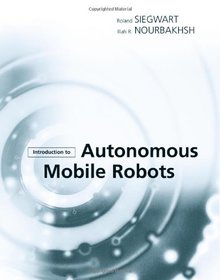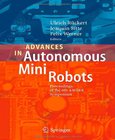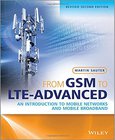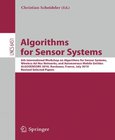Introduction to Autonomous Mobile Robots

Book Details:
| Publisher: | The MIT Press |
| Series: | MIT Press |
| Author: | Roland Siegwart |
| Edition: | 1 |
| ISBN-10: | 026219502X |
| ISBN-13: | 9780262195027 |
| Pages: | 335 |
| Published: | Mar 05 2004 |
| Posted: | Nov 19 2014 |
| Language: | English |
| Book format: | |
| Book size: | 7.91 MB |
Book Description:
Mobile robots range from the teleoperated Sojourner on the Mars Pathfinder mission to cleaning robots in the Paris Metro. Introduction to Autonomous Mobile Robots offers students and other interested readers an overview of the technology of mobility -- the mechanisms that allow a mobile robot to move through a real world environment to perform its tasks -- including locomotion, sensing, localization, and motion planning. It discusses all facets of mobile robotics, including hardware design, wheel design, kinematics analysis, sensors and perception, localization, mapping, and robot control architectures.The design of any successful robot involves the integration of many different disciplines, among them kinematics, signal analysis, information theory, artificial intelligence, and probability theory. Reflecting this, the book presents the techniques and technology that enable mobility in a series of interacting modules. Each chapter covers a different aspect of mobility, as the book moves from low-level to high-level details. The first two chapters explore low-level locomotory ability, examining robots' wheels and legs and the principles of kinematics. This is followed by an in-depth view of perception, including descriptions of many "off-the-shelf" sensors and an analysis of the interpretation of sensed data. The final two chapters consider the higher-level challenges of localization and cognition, discussing successful localization strategies, autonomous mapping, and navigation competence. Bringing together all aspects of mobile robotics into one volume, Introduction to Autonomous Mobile Robots can serve as a textbook for coursework or a working tool for beginners in the field.
Download Link:
Related Books:
Advances in Autonomous Mini Robots
Autonomous robots must carry out useful tasks all by themselves relying entirely on their own perceptions of their environment. The cognitive abilities required for autonomous action are largely independent of robot size, which makes mini robots attractive as artefacts for research, education and entertainment. Autonomous mini robots must be small enough for experimentation on a desktop or a small laboratory. They must be easy to carry and safe for interaction with humans. They must not be expensive. Mini robot designers have to work at the leading edge of technology so that their creations can carry out purposeful autonomic action under these constraints. Since 2001 researchers have met every two years for an international symposium to report on the...
From GSM to LTE-Advanced
An Introduction to Mobile Networks and Mobile Broadband
2nd Edition
This revised edition of Communication Systems from GSM to LTE: An Introduction to Mobile Networks and Mobile Broadband Second Edition (Wiley 2010) contains not only a technical description of the different wireless systems available today, but also explains the rationale behind the different mechanisms and implementations; not only the 'how' but also the 'why'. In this way, the advantages and also limitations of each technology become apparent. Offering a solid introduction to major global wireless standards and comparisons of the different wireless technologies and their applications, this edition has been updated to provide the latest directions and ...
Algorithms for Sensor Systems
6th International Workshop on Algorithms for Sensor Systems, Wireless Ad Hoc Networks and Autonomous Mobile Entities
This volume contains the papers presented at ALGOSENSORS 2010, the 6th International Workshop on Algorithms for Sensor Systems, Wireless Ad Hoc Networks and Autonomous Mobile Entities, held on July 5, 2010 in Bordeaux, France. There were 31 submissions. Each submission was reviewed by four Program Committee members. The committee decided to accept 15 papers, among them two brief announcements. TheProgramCommitteewouldliketothankallwhosubmittedpapersandall the external reviewers who helped us evaluate the submissions. As the Program Chair of ALGOSENSORS 2010, I would like to express my deep gratitude to the Program Committee for all of their work during the paper review process and the fruitful discussions. I would also like to thank the Workshops Cha...
2007 - 2021 © eBooks-IT.org



